This beef ragu with pappardelle pasta is one of my favorite Italian inspired dinners. After a long slow roast in the oven, budget friendly beef chuck becomes fall apart tender. Simmered with juicy tomatoes and herbs, it turns into the most incredible shredded beef ragu.
Short on time tonight? If you’re looking for a quick pasta recipe, try my homemade alfredo sauce, red pepper pasta sauce, or this 20-minute spicy rigatoni vodka.
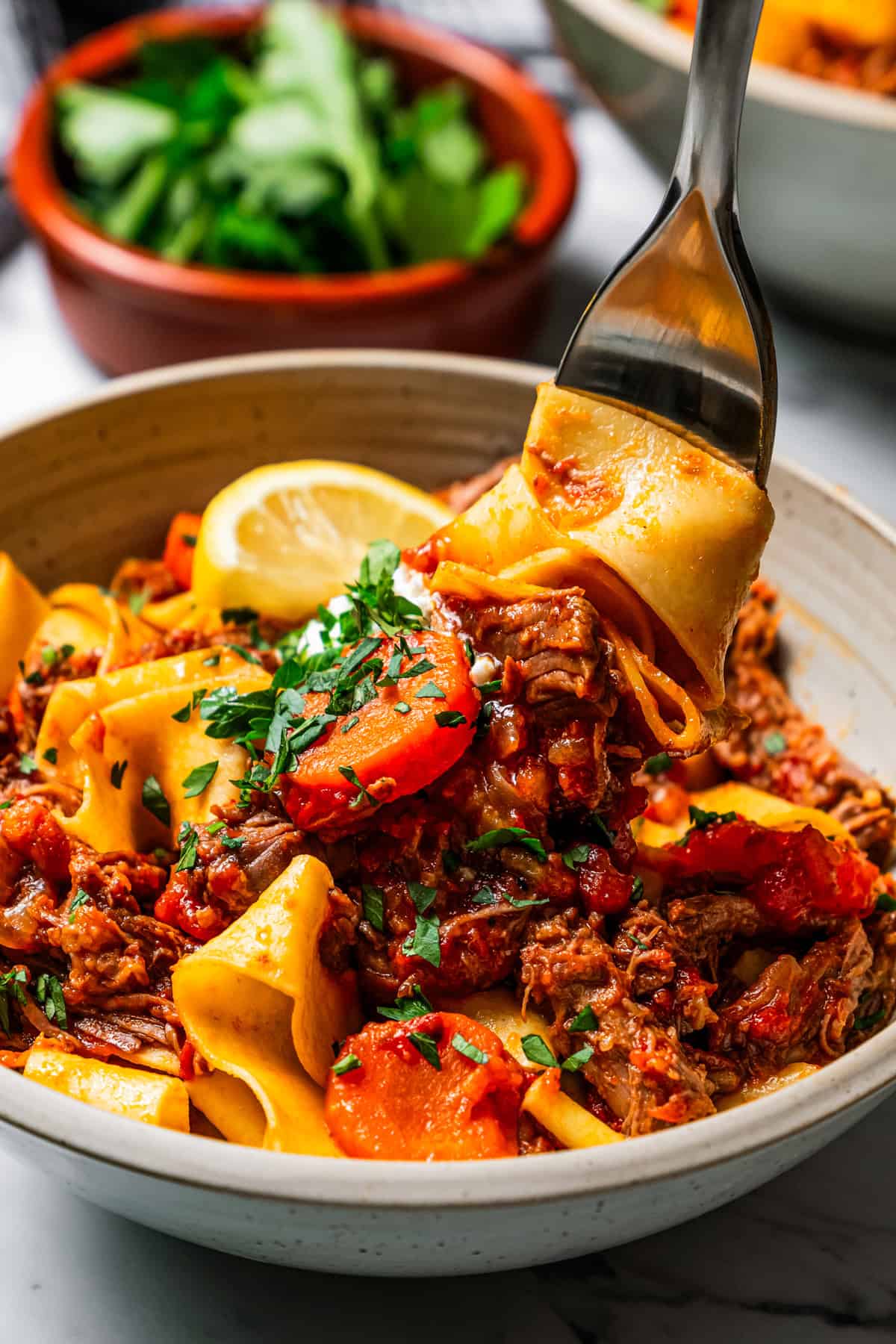
A slow-cooked sauce of tender beef and tomatoes, beef ragu is a traditional Italian recipe that takes a bit of patience. BUT the ingredients and method are super simple. This classic meat sauce gets simmered in a Dutch oven for at least a couple of hours, like a pot roast. By the time it’s finished cooking, you’re rewarded with beef that practically comes apart on its own in the savory tomato sauce. I serve my ragu over wide noodles called pappardelle, but it’s delicious with any pasta.
Why You’ll Love This Slow Cooked Beef Ragu Recipe
- The flavor builds for hours. Like Mexican birria, Irish beef stew, and French beef bourguignon, good things come to those who wait (for the beef to finish slow cooking). Italian ragu is the kind of slow-simmering sauce that weekend afternoons are made for.
- Hearty shredded beef. Sure, you can make authentic ragu alla Bolognese with ground beef, but I’m all about the slow-cooked, shredded beef in this recipe. It soaks up the sauce and gives this ragu a heartier texture.
- Easy. It’s true, beef ragu takes time. But there’s only about 10 minutes of hands-on prep before you leave most of the work to your oven!
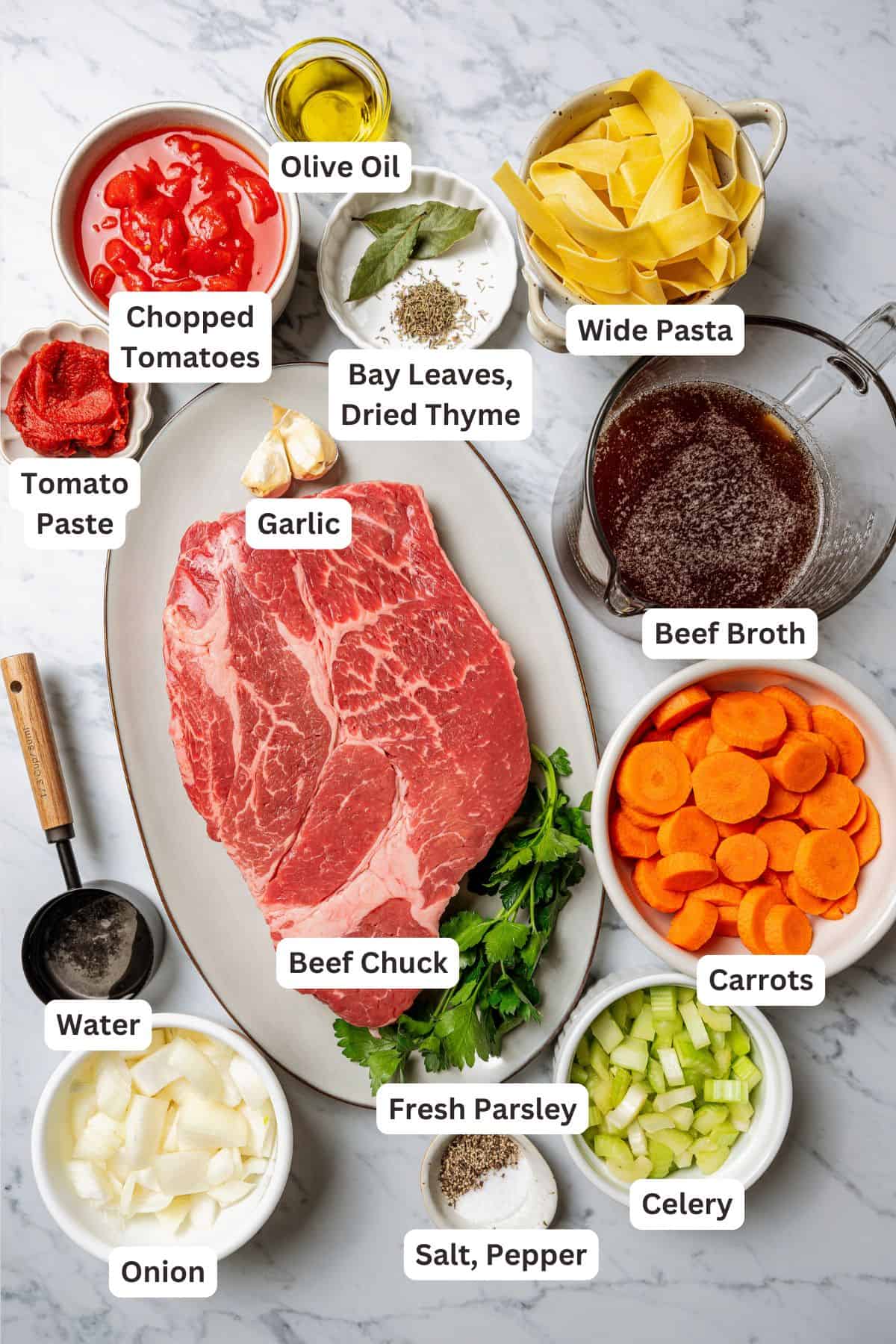
Recipe Ingredients
These are the ingredients you’ll need to make this shredded beef ragu sauce. I’ve also included a few notes below for easy swaps and extra tips to get the best flavor. Please scroll to the printable recipe card for the full details.
- Beef – I prefer beef chuck, but you can make ragu with any slow-cooking cut of meat, such as brisket, pork shoulder, or lamb.
- Olive Oil – I recommend refined olive oil for searing and sautéeing. You could also use another cooking oil, like avocado or vegetable oil.
- Carrots, Celery, and Onion – Chopped. I cut the carrots into ½” rounds.
- Garlic – Freshly chopped or minced. If you don’t have fresh garlic, substitute ½ teaspoon of garlic powder instead.
- Tomato Paste – You could also use tomato purée or tomato sauce.
- Beef Broth – I highly recommend beef broth, as the flavor is richer and deeper than chicken broth. You can also substitute half of the broth with dry red wine if you’d like.
- Canned Tomatoes – If you can find canned San Marzano tomatoes, these have the best flavor and sweetness. Otherwise, choose your favorite can of chopped tomatoes. You could always add a pinch of sugar (to taste) later on.
- Herbs – Bay leaves, dried thyme, and freshly chopped parsley. You could use fresh thyme, too, though you’ll need approximately 3x the amount of fresh to dried.
- Pasta – Pappardelle is the traditional choice for ragu. Otherwise, you can use any wide pasta or short-cut varieties.
The Best Pasta to Serve With Ragu
Most pasta sauces are pretty interchangeable in terms of the pasta you pair them with, whether that’s spaghetti, fettuccine, etc. While the same can be said about this beef ragu, the best pasta for rich, meaty sauces like ragu has to be pappardelle. The wide, flat noodles give the shredded beef and sauce plenty of surface area to cling to.
Pro tip: If you don’t have pappardelle but you have a box of lasagna sheets in the pantry, cut the lasagna sheet lengthwise into 1” strips. Afterward, boil the pasta according to the directions on the package. Voila!
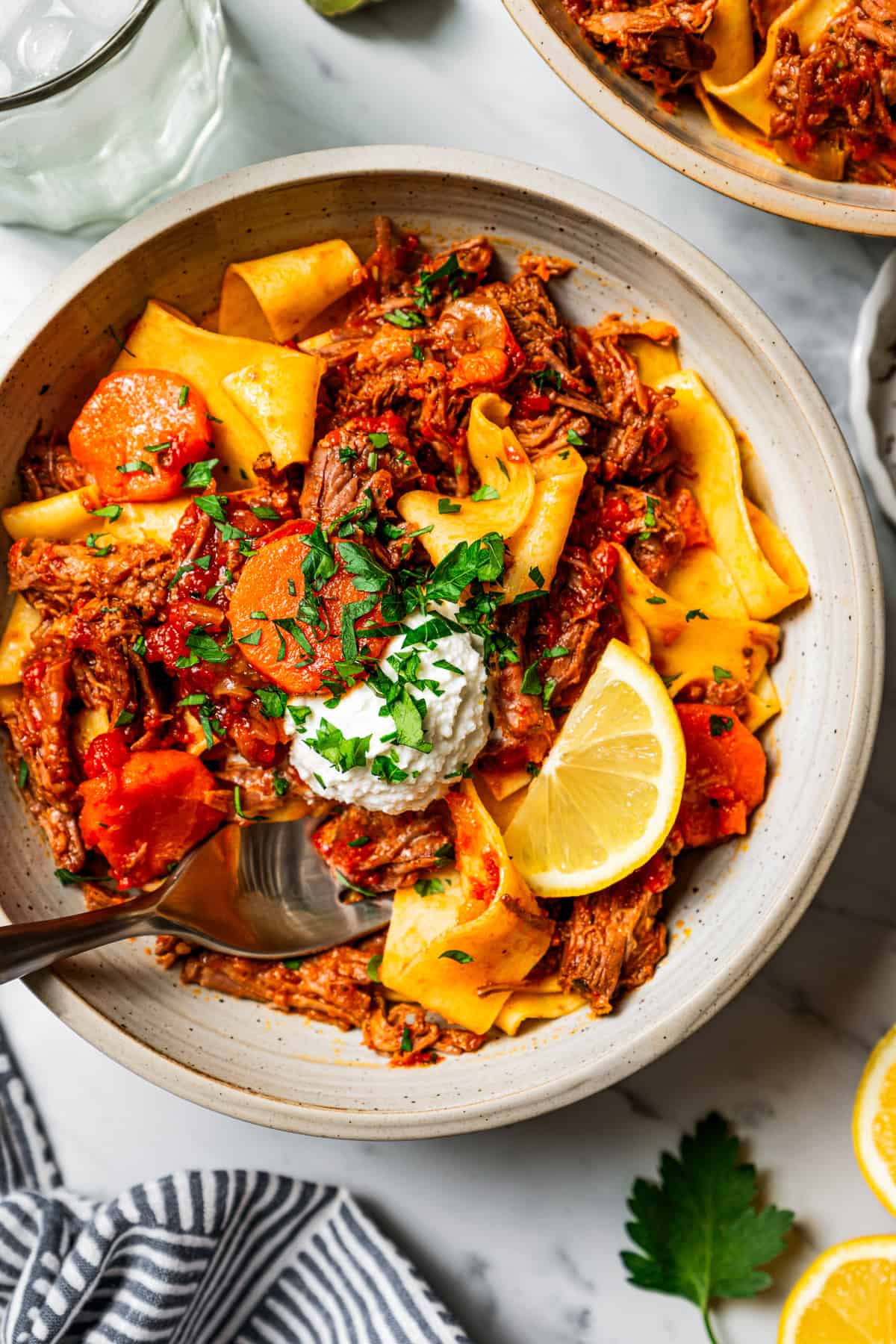
Secrets to Really Good Ragu
- Build layers of flavor. You’ll notice that this ragu recipe involves searing the beef, cooking the vegetables, and layering the sauce ingredients separately before everything comes together to cook in the oven. Don’t take shortcuts! Each step brings out the flavors of the ingredients, which is key.
- Cook the beef for long enough. Beef chuck is perfect for slow-cooking recipes like beef ragu. The key word is “slow cooking.” After hours in the oven, the meat becomes fall-apart tender enough to shred easily with a fork. Make sure to budget enough time for the ragu to cook fully, however, or it’ll be tough.
- Save some pasta water. Before you drain the cooked pasta, reserve about 1 cup of the leftover pasta water. All that starchy water is great for adding flavor to the finished ragu. Add a splash, and more as needed, if your sauce has thickened during cooking.
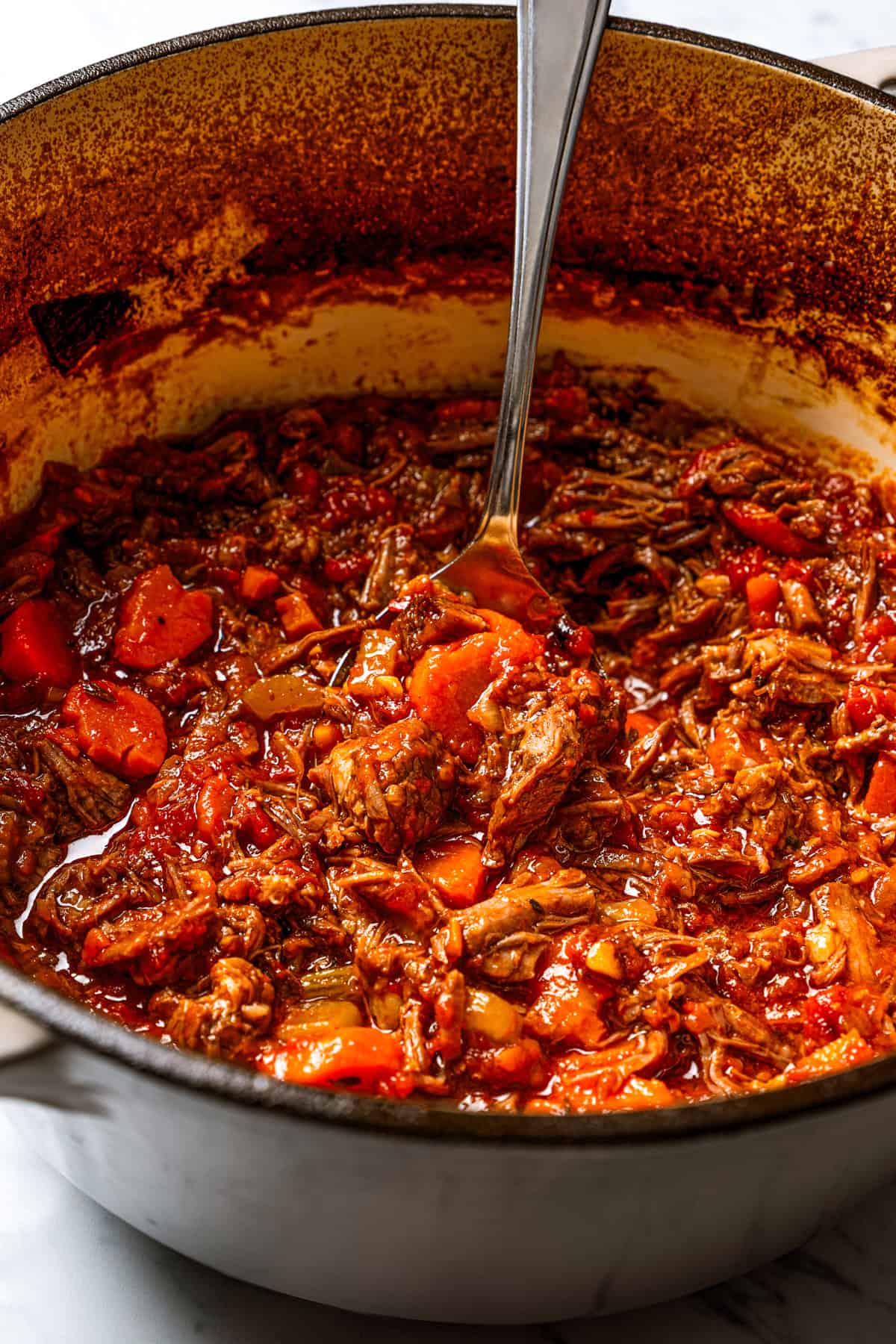
Frequently Asked Questions
Ragu and Bolognese sauce are both in the meat sauce family, with a few key differences. Ragu is more of a rich tomato sauce with chunks of beef throughout. Meanwhile, Bolognese is made with milk and tends to be thicker, creamier, and much less tomato-y. Check out my rigatoni Bolognese if you’re looking for another hearty pasta dinner this week!
If the beef chuck is still tough, even after it’s been in the oven for 2 ½ to 3 hours, chances are it simply needs to cook for longer. Check that the sauce is bubbling beneath the lid. If it’s not, the heat is too low. If it is bubbling gently, stay patient. The beef should soften soon enough!
Yes! You can make this beef ragu recipe with ground beef if you’d prefer. I still recommend browning the mince in the Dutch oven first and following the rest of the recipe as directed. You may find that ground beef needs less time to cook. You could even get away with simmering the sauce completely on the stovetop.
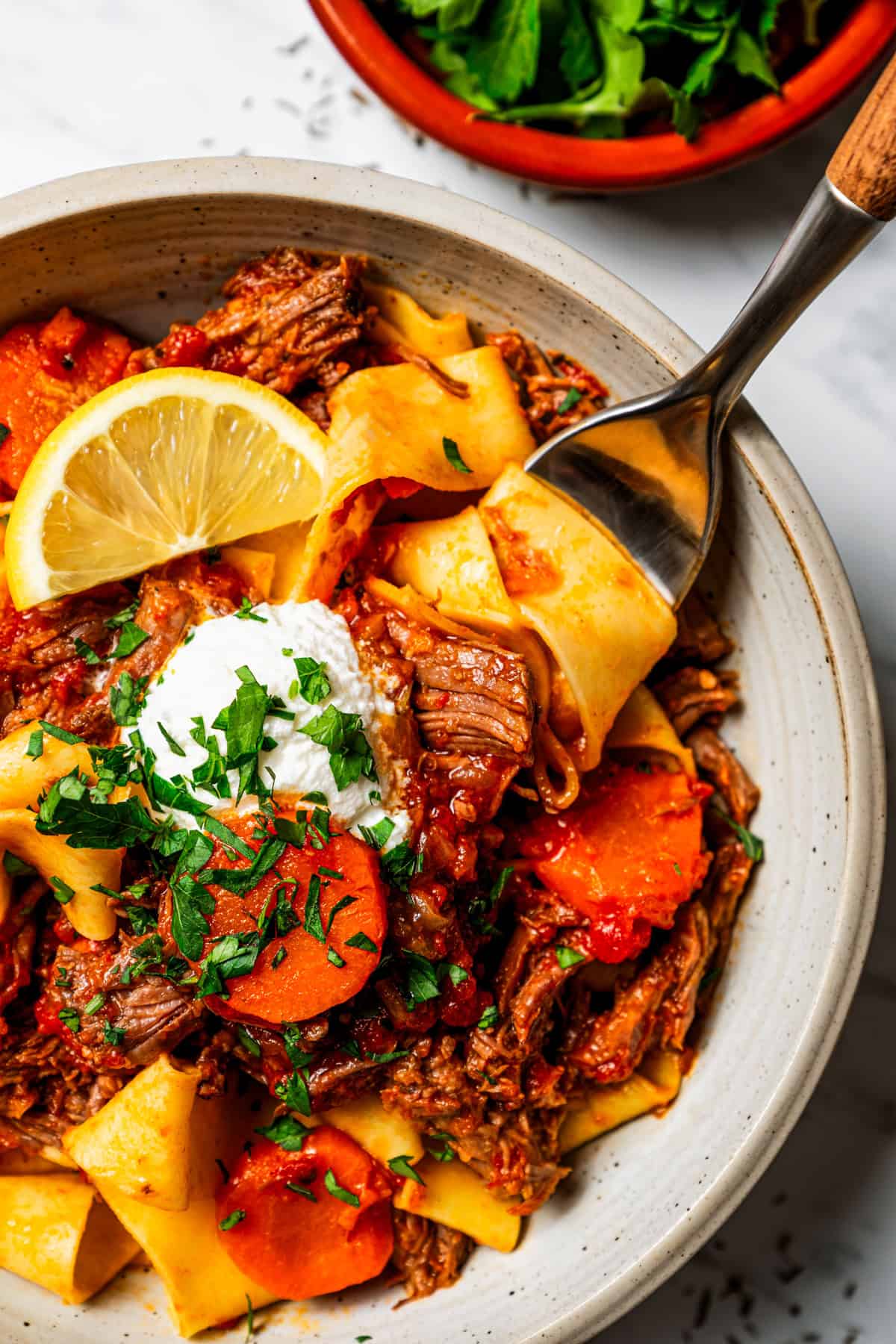
Storing and Reheating Leftover Sauce
- Refrigerate. Store leftover beef ragu in an airtight container in the fridge for up to 4 days.
- Reheat. Warm up the sauce on the stovetop or in the microwave, stirring every so often so that it heats through evenly.
- Freeze. This ragu freezes well for up to 2 months. I like to portion the leftovers into smaller freezer-safe containers to thaw and reheat as needed.
Pin this now to find it later
Pin It
Prepare the beef. Cut the beef into four pieces and season it to taste with salt and pepper.
Sear the beef. Heat the olive oil in a Dutch oven over medium-high heat. Sear the beef on all sides, then remove it onto a plate. Meanwhile, preheat your oven to 350˚F.
Sauté the veggies. In the same Dutch oven, add carrots, celery, and onions. Cook, stirring over medium-high heat for 5 minutes.
Add garlic and tomato paste. Add the garlic and cook for 30 seconds or until fragrant. Add tomato paste and cook for 30 seconds.
Deglaze the pan. Pour the beef broth gradually into the Dutch oven and stir to lift any browned bits from the bottom of the pan.
Add tomatoes. Add the can of chopped tomatoes and water. Stir well to combine. Bring to a simmer and cook for 10 minutes.
Add herbs. Add the bay leaves and thyme. Season it all with salt and pepper to taste.
Cook in the oven. Cover the beef ragu with a lid and pop it in the oven for 2½-3 hours or until tender.
Shred and continue to cook on the stovetop. Remove it from the oven. Then, remove the beef from the pot and shred it with two forks. Place the shredded beef back into the pot and simmer on the stove over medium heat for 30 minutes.
Boil the pasta. While the ragu is cooking, cook the pasta according to the directions on the package.
Put it all together. Toss freshly cooked pasta with the ragu and garnish with chopped parsley before serving.
Serving: 1.5cups | Calories: 574kcal | Carbohydrates: 49g | Protein: 40g | Fat: 25g | Saturated Fat: 9g | Polyunsaturated Fat: 3g | Monounsaturated Fat: 13g | Trans Fat: 1g | Cholesterol: 152mg | Sodium: 474mg | Potassium: 1130mg | Fiber: 4g | Sugar: 6g | Vitamin A: 3650IU | Vitamin C: 13mg | Calcium: 92mg | Iron: 6mg
Nutritional info is an estimate and provided as courtesy. Values may vary according to the ingredients and tools used. Please use your preferred nutritional calculator for more detailed info.
How to Make Beef Ragu
You’ll need a Dutch oven or a similar oven-safe, deep covered casserole dish for this recipe. Then, embrace your inner nonna and follow the steps here:
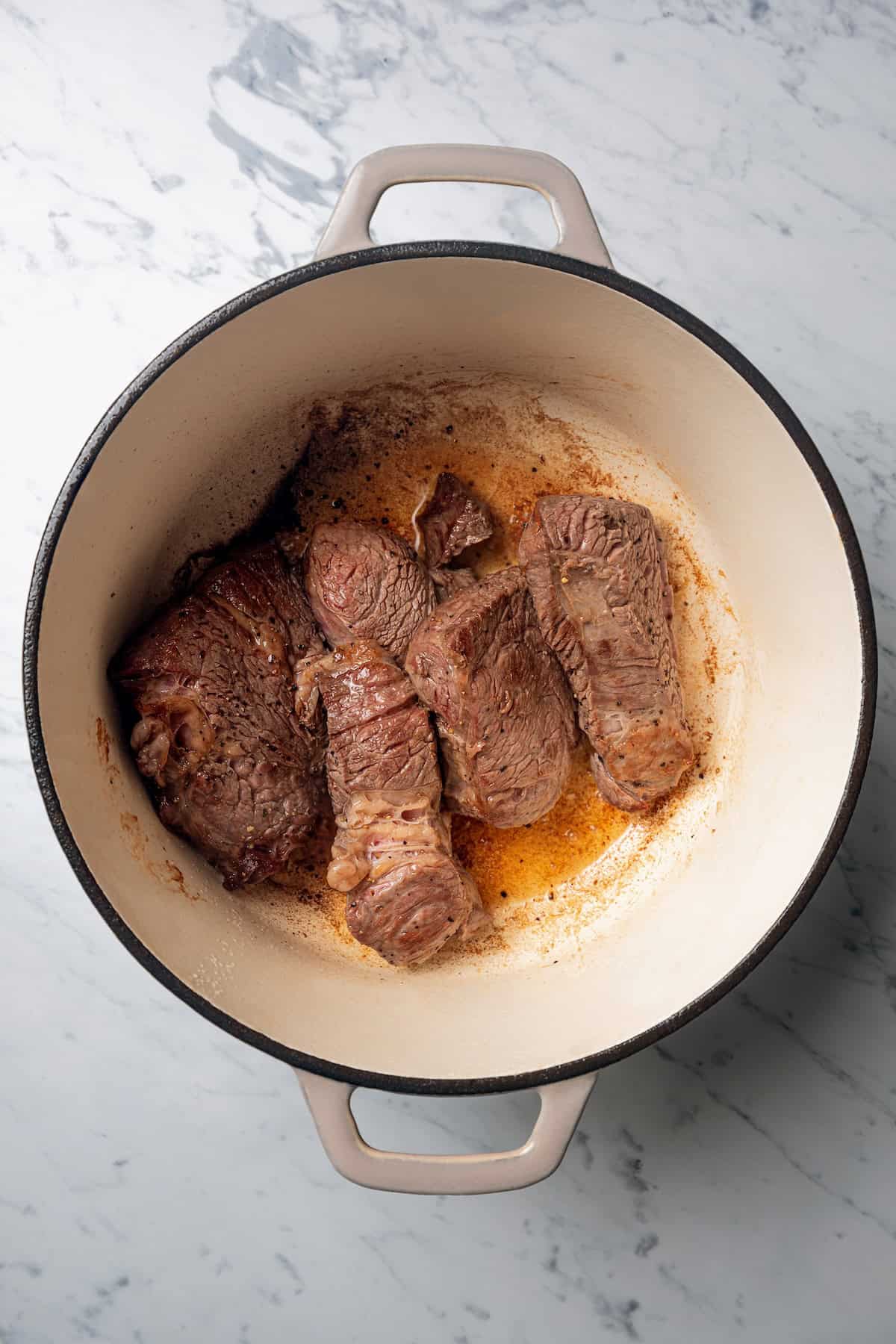
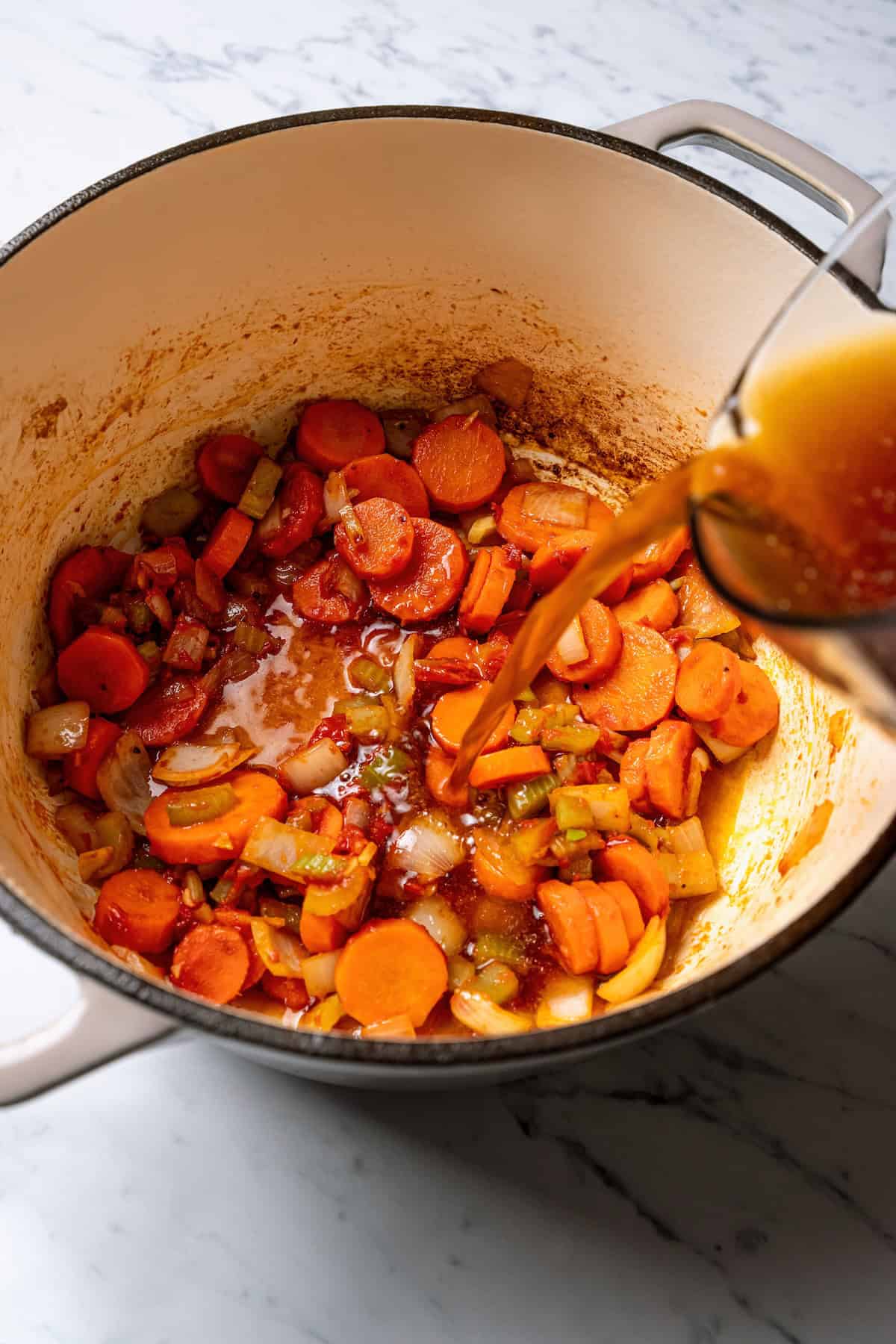
- Prepare the beef. Start by cutting the beef chuck into four even-sized pieces. Season the beef with salt and pepper, and then sear it in a large Dutch oven with oil to brown it on all sides. Afterward, move the beef to a plate.
- Cook the veggies. While the oven preheats (350ºF), add your chopped carrots, celery, and onions to the same pot. Sauté over medium-high heat for a few minutes, stirring often. Next, stir in the garlic and tomato paste.
- Deglaze the pot. Now, pour in the beef broth. Use a wooden spoon to scrape any stuck-on bits from the bottom of the pot.
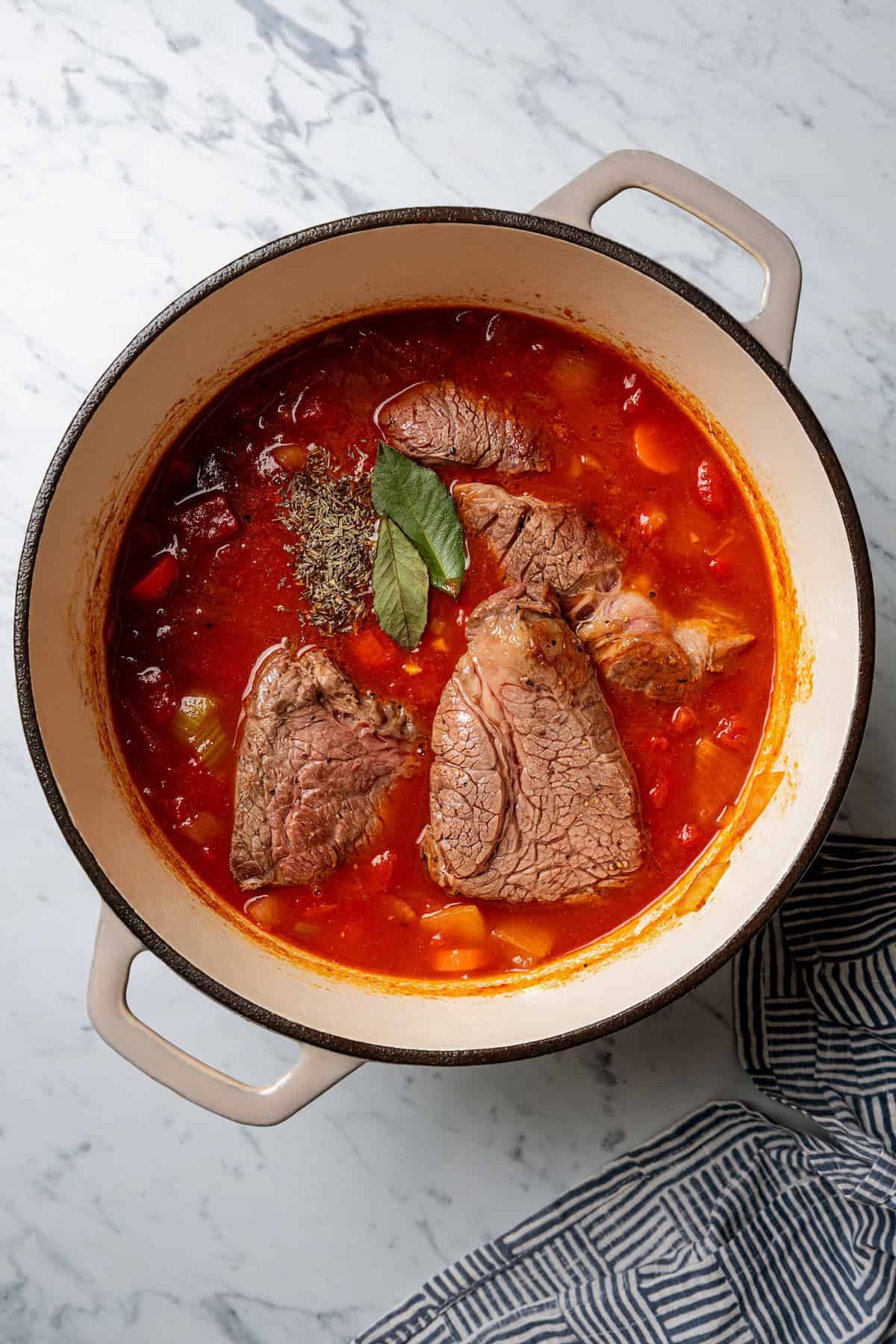
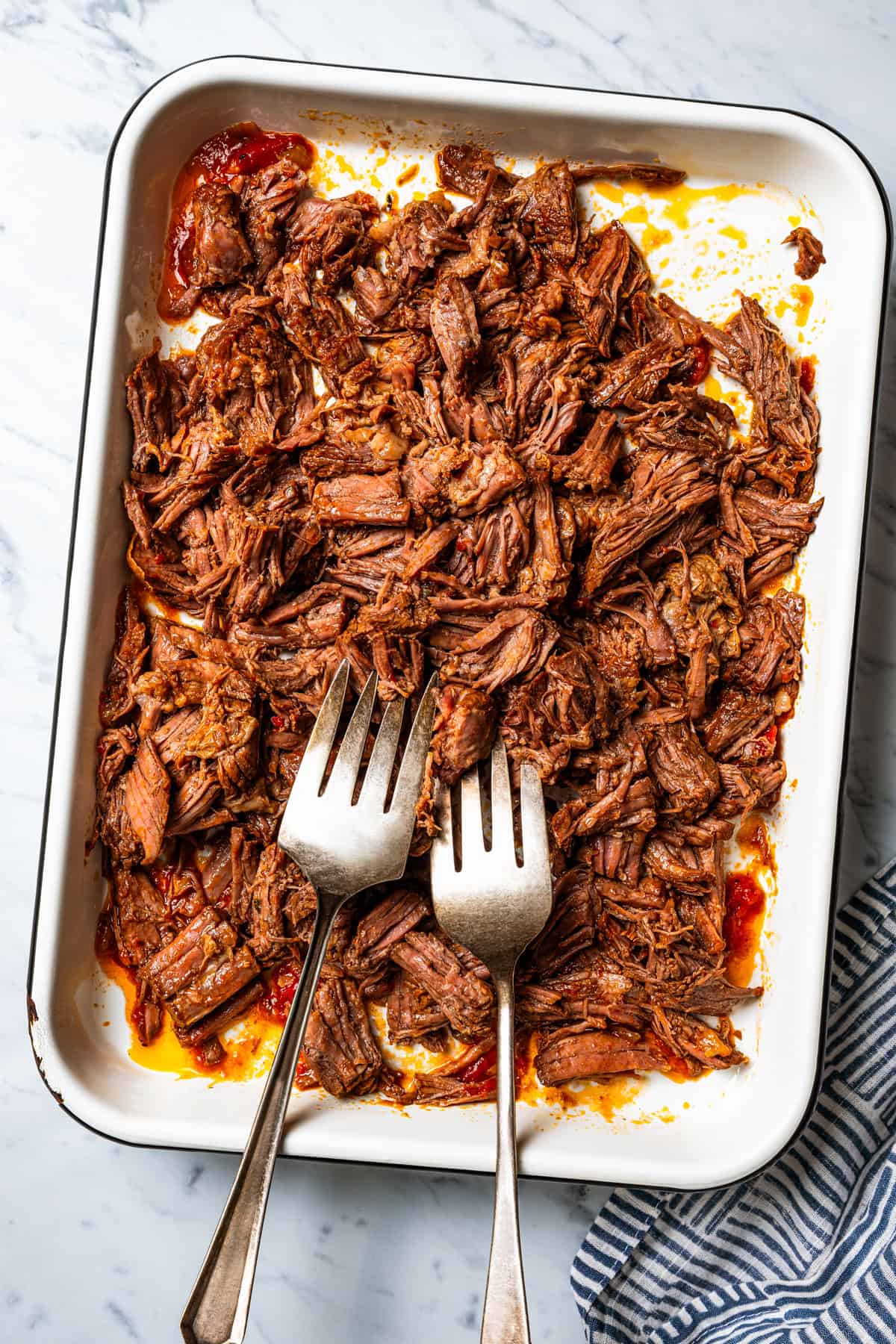
- Add tomatoes and simmer. Lastly, stir in the canned tomatoes and ¼ cup of water, and bring the whole thing to a simmer.
- Add herbs. After 10 minutes, drop in your bay leaves and sprinkle in the thyme. Check the sauce for seasoning and add salt and pepper as needed.
- Add the beef and cook. Return the seared beef pieces to the Dutch oven, then cover the pot with a lid and place it into the oven. You’ll leave it in there to cook at 350ºF for a good 2 ½ to 3 hours until the meat is fall-apart-tender.
- Shred the beef. Once your ragu has cooked, remove the beef and shred it before returning it to the pot one more time. Simmer the ragu on the stovetop now, over medium heat for about 30 minutes.
- Cook the pasta. While the sauce simmers, boil your pappardelle according to the directions on the package.
- Put it all together. Toss the drained pasta with the ragu, sprinkle over some parsley, and serve.
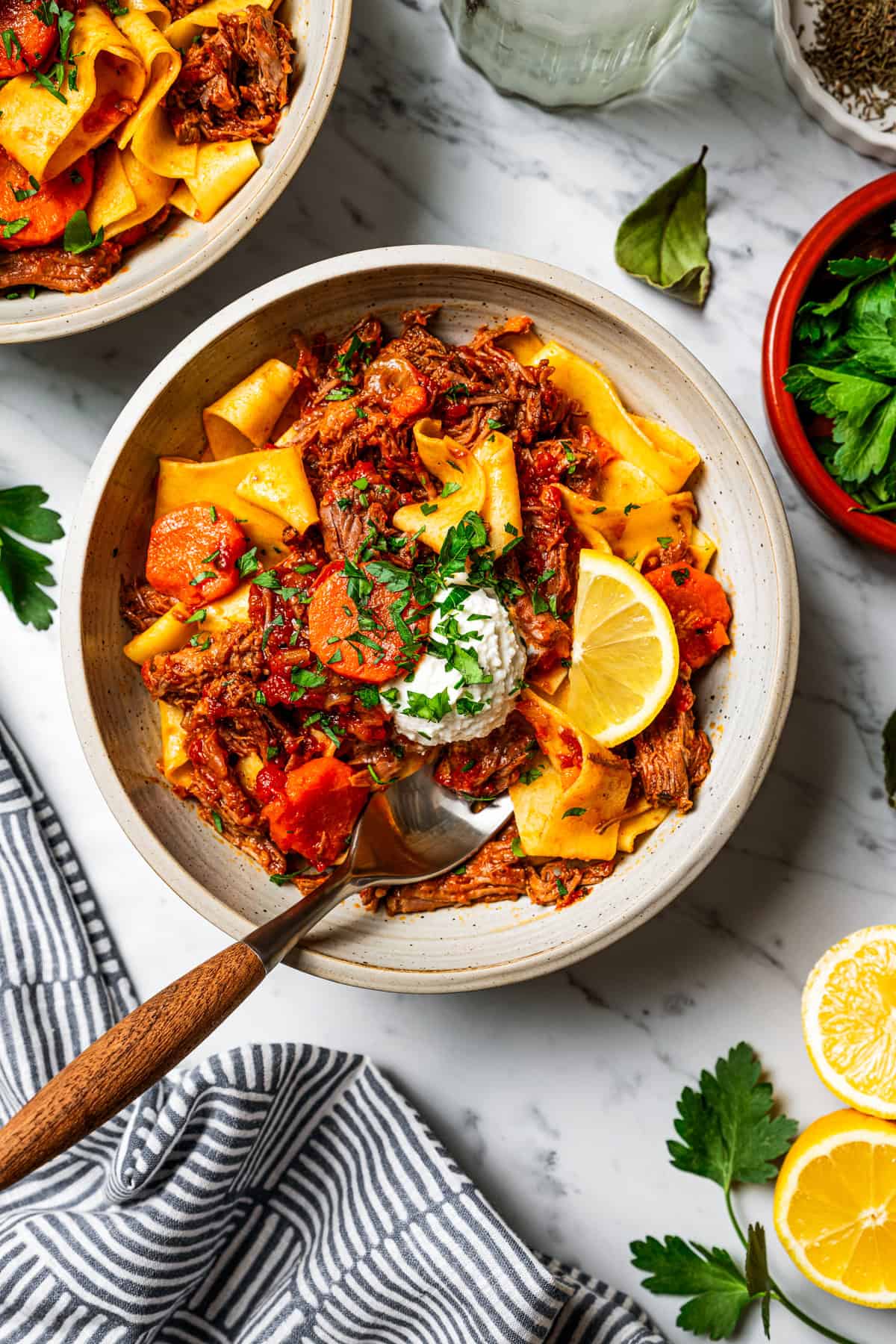

diethood.com (Article Sourced Website)
#Beef #Ragu #Slow #Cooked #Beef #Ragu #Pappardelle

